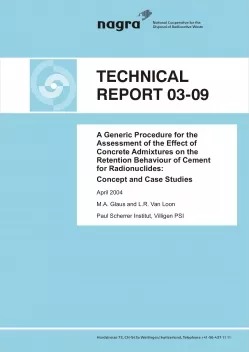
Technical Report NTB 03-09
A Generic Procedure for the Assessment of the Effect of Concrete Admixtures on the Retention Behaviour of Cement for Radionuclides: Concept and Case Studies
Concrete admixtures are unavoidable components of cements used for the conditioning of radioactive waste and of concretes used in the construction of a cementitious underground repository for the geological disposal of radioactive waste.
Almost nothing is known about the influence of concrete admixtures on the sorption of radionuclides on cement, which is one of the main retardation mechanisms responsible for the isolation of radionuclides from the environment. In this work a screening procedure is proposed in the form of a checklist, through which it can be decided whether or not a specific concrete admixture may have adverse effects on the sorption of radionuclides by cement. The screening procedure is intended to be generic and applicable to any concrete admixture that may be used in the future. It focuses on the following potential main effects of concrete admixtures or their transformation products possibly formed under highly alkaline conditions: (i) interaction between radionuclides and concrete admixture in solution (complexation) and (ii) competition for surface sites between concrete admixtures and radionuclides or other strong complexants sorbing on cement. The screening procedure is set up in a hierarchical manner. The degree of complexity of the procedure increases with increasing depth of the investigations. The effort for the assessment of a specific concrete admixture under investigation can be kept thereby to a reasonable minimum.
In parallel to the development of a suitable experimental protocol, a few selected concrete admixtures, i.e. sulfonated naphthalene-formaldehyde condensates, lignosulfonates and a plasticiser used at the Paul Scherrer Institut for waste conditioning, were subjected to this screening procedure. The effect of these concrete admixtures on the sorption properties of Ni(II), Eu(III) and Th(IV) on cement was investigated using crushed hardened cement paste (HCP) and cement pastes prepared in the presence of these concrete admixtures. Although some of the concrete admixtures investigated were shown to be strong complexants, no adverse effect on the sorption of the radionuclides tested could be observed under realistic conditions, i.e. at representative HCP to pore water ratios and representative concrete admixture to cement ratios. With the exception of lignosulfonate, this finding could be explained by the sorption of the concrete admixtures onto the HCP, which could be modelled within an order of magnitude using a Langmuir isotherm. The pore water concentrations of the concrete admixtures tested were thereby reduced to levels at which the formation of radionuclide complexes was no longer of importance. Further, the sorption model suggests that the HCP surface does not become saturated with the concrete admixtures tested. The sorption on HCP of the radionuclides tested and isosaccharinic acid, a strong complexant produced in cement conditioned wastes containing cellulose, was found to be unaffected by the amount of concrete admixtures sorbed on the HCP under the experimental conditions investigated. Chemical transformation of the concrete admixtures studied was not investigated in detail. An indication for a chemical transformation with a possible impact on radionuclides sorption was only found in the case of lignosulfonates using the methods applied in this study.
As a result of the experiments carried out within the framework of this study, it can be concluded that the proposed screening procedure is well suited for a broad assessment of the effect of concrete admixtures on the retention behaviour of HCP for radionuclides. However, more substance specific knowledge may be needed for a comprehensive assessment, if, in a specific case, it is not possible to break down the complexity of the system, cement – concrete admixture – radionuclide retention, in the manner proposed in this work.
